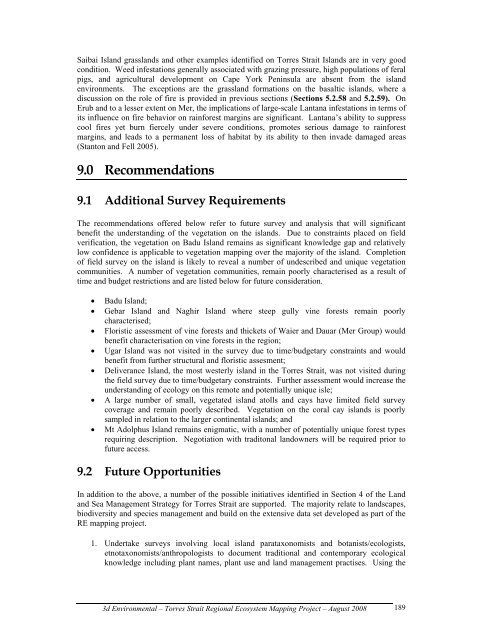Appendix 2 - Vegetation Communities and Regional Ecosystems
Appendix 2 - Vegetation Communities and Regional Ecosystems
Appendix 2 - Vegetation Communities and Regional Ecosystems
Create successful ePaper yourself
Turn your PDF publications into a flip-book with our unique Google optimized e-Paper software.
Saibai Isl<strong>and</strong> grassl<strong>and</strong>s <strong>and</strong> other examples identified on Torres Strait Isl<strong>and</strong>s are in very good<br />
condition. Weed infestations generally associated with grazing pressure, high populations of feral<br />
pigs, <strong>and</strong> agricultural development on Cape York Peninsula are absent from the isl<strong>and</strong><br />
environments. The exceptions are the grassl<strong>and</strong> formations on the basaltic isl<strong>and</strong>s, where a<br />
discussion on the role of fire is provided in previous sections (Sections 5.2.58 <strong>and</strong> 5.2.59). On<br />
Erub <strong>and</strong> to a lesser extent on Mer, the implications of large-scale Lantana infestations in terms of<br />
its influence on fire behavior on rainforest margins are significant. Lantana’s ability to suppress<br />
cool fires yet burn fiercely under severe conditions, promotes serious damage to rainforest<br />
margins, <strong>and</strong> leads to a permanent loss of habitat by its ability to then invade damaged areas<br />
(Stanton <strong>and</strong> Fell 2005).<br />
9.0 Recommendations<br />
9.1 Additional Survey Requirements<br />
The recommendations offered below refer to future survey <strong>and</strong> analysis that will significant<br />
benefit the underst<strong>and</strong>ing of the vegetation on the isl<strong>and</strong>s. Due to constraints placed on field<br />
verification, the vegetation on Badu Isl<strong>and</strong> remains as significant knowledge gap <strong>and</strong> relatively<br />
low confidence is applicable to vegetation mapping over the majority of the isl<strong>and</strong>. Completion<br />
of field survey on the isl<strong>and</strong> is likely to reveal a number of undescribed <strong>and</strong> unique vegetation<br />
communities. A number of vegetation communities, remain poorly characterised as a result of<br />
time <strong>and</strong> budget restrictions <strong>and</strong> are listed below for future consideration.<br />
• Badu Isl<strong>and</strong>;<br />
• Gebar Isl<strong>and</strong> <strong>and</strong> Naghir Isl<strong>and</strong> where steep gully vine forests remain poorly<br />
characterised;<br />
• Floristic assessment of vine forests <strong>and</strong> thickets of Waier <strong>and</strong> Dauar (Mer Group) would<br />
benefit characterisation on vine forests in the region;<br />
• Ugar Isl<strong>and</strong> was not visited in the survey due to time/budgetary constraints <strong>and</strong> would<br />
benefit from further structural <strong>and</strong> floristic assesment;<br />
• Deliverance Isl<strong>and</strong>, the most westerly isl<strong>and</strong> in the Torres Strait, was not visited during<br />
the field survey due to time/budgetary constraints. Further assessment would increase the<br />
underst<strong>and</strong>ing of ecology on this remote <strong>and</strong> potentially unique isle;<br />
• A large number of small, vegetated isl<strong>and</strong> atolls <strong>and</strong> cays have limited field survey<br />
coverage <strong>and</strong> remain poorly described. <strong>Vegetation</strong> on the coral cay isl<strong>and</strong>s is poorly<br />
sampled in relation to the larger continental isl<strong>and</strong>s; <strong>and</strong><br />
• Mt Adolphus Isl<strong>and</strong> remains enigmatic, with a number of potentially unique forest types<br />
requiring description. Negotiation with traditonal l<strong>and</strong>owners will be required prior to<br />
future access.<br />
9.2 Future Opportunities<br />
In addition to the above, a number of the possible initiatives identified in Section 4 of the L<strong>and</strong><br />
<strong>and</strong> Sea Management Strategy for Torres Strait are supported. The majority relate to l<strong>and</strong>scapes,<br />
biodiversity <strong>and</strong> species management <strong>and</strong> build on the extensive data set developed as part of the<br />
RE mapping project.<br />
1. Undertake surveys involving local isl<strong>and</strong> parataxonomists <strong>and</strong> botanists/ecologists,<br />
etnotaxonomists/anthropologists to document traditional <strong>and</strong> contemporary ecological<br />
knowledge including plant names, plant use <strong>and</strong> l<strong>and</strong> management practises. Using the<br />
3d Environmental – Torres Strait <strong>Regional</strong> Ecosystem Mapping Project – August 2008<br />
189


